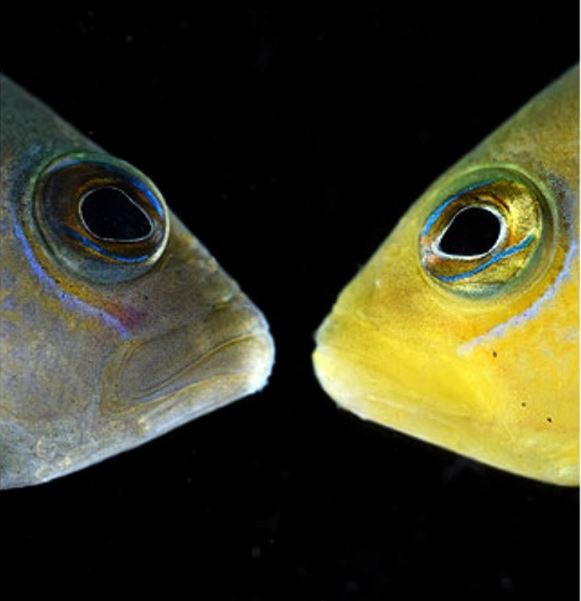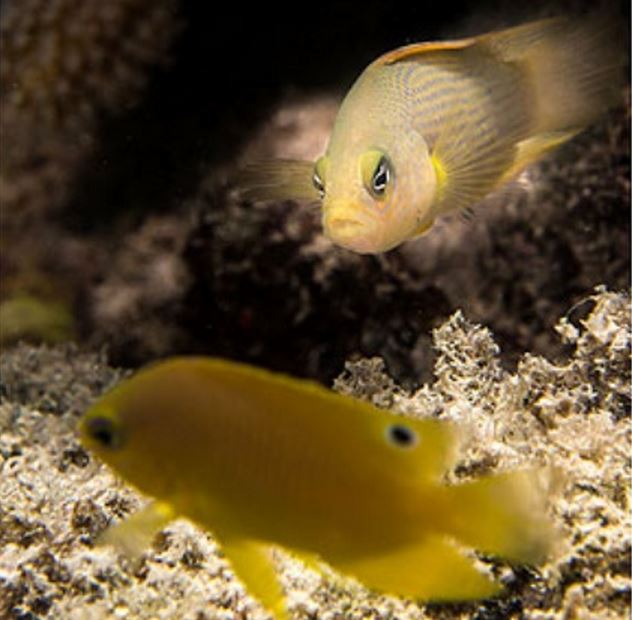The Dusky Dottyback, a fish that lives on the Australian Great Barrier Reef, mimics the colours of other fishes and its surroundings in order to catch their juvenile offspring or hide from predators, an international team of researchers reported in the academic journal Current Biology (citation below).
The researchers tested the fish’s ability to change colour to elude potential predators, and found its strategy was very effective.
The Australian Great Barrier Reef, like other tropical reefs, is among the most spectrum-rich habitats in the world. However, scientists are still puzzled by the diversity in colour. Why do coral reefs host such a wide variety of colorful organisms such as fish, crustaceans and corals?

Brown to yellow: the fish changes colour to mimic other fish in their environment so they can eat their juveniles. (Image Credit: N. Justin Marshall)
The Dusky Dottyback, known scientifically as Pseudochromis fuscus, is a small predatory fish found across the Indo-Pacific. It occurs in a variety of colorations and has the unusual ability to alter its colour.
It was not until this study was underway that zoologists learned why the fish had this unusual (but not unique) ability.
An international team of researchers from Australia, the UK, Switzerland, Sweden, and Canada, led by evolutionary biologists Professor Walter Salzburger and Dr. Fabio Cortesi from the University of Basel, can now explain what their colour-changing ability is for?
Researchers had assumed that the colour variety was due to either their habitat background or sex.
In this study, the zoologists discovered that Dottybacks can actively alter their colour in a relatively short amount of time. Their goal is to mimic other fish species in their surroundings so that they can get close to their offspring and eat them.

The Dottyback disguised as a harmless fish eyeing up its prey. (Image Credit: Christopher E. Mirbach)
Wolf in sheep’s clothing
Nature is full of examples of animals using deception to improve their reproductive opportunities, protect themselves, scare off rivals, or have better access to food. However, if it is overused or out of context, the impostor risks losing its cover.
Dottybacks mimic the colour of harmless fish species in their surroundings to prevent their prey from sensing danger – their prey being juveniles of the mimicked fish.
First-author Dr. Fabio Cortesi said:
“This strategy is very similar to the classic example of the wolf in sheep’s clothing. However, while the wolf may be found out eventually, dottybacks are able to change their coloration, making it difficult for their prey to learn about the threat they impose.”
Protection from predators
In order to determine how effective the fish’s colour changing abilities were at protecting it from predators, the researchers trained some larger coral trout to strike at images of Dottybacks in front of a range of backgrounds.
They found that when the Dottybacks had changed colour to match their surroundings the coral trout struck considerably less often at the images.
Dr. Cortesi said:
“The dottybacks have developed an intricate form of mimicry that not only gives them a predatory advantage but also protects them from their own predators.”
Perhaps this study has helped solve part of the riddle regarding the range of hues in tropical coral reefs. Their inhabitants, with such an incredible variety of colours and shapes, are able to accomplish several functions which improve their chances of survival.
Sea slugs use vivid colours as a warning to predators of their horrible taste, stonefish hide by mimicking their surroundings, while cuttlefish can change colour from one second to the next to hide from predators or attract a sexual partner.
Citation: “Phenotypic Plasticity Confers Multiple Fitness Benefits to a Mimic,” Fabio Cortesi, William E. Feeney, Maud C.O. Ferrari, Peter A. Waldie, Genevieve A.C. Phillips, Eva C. McClure, Helen N. Sköld, Walter Salzburger, N. Justin Marshall, Karen L. Cheney. Current Biology. Published online 19 March, 2015. DOI: 10.1016/j.cub.2015.02.013.
Video – Wolf in Sheep’s Clothing
